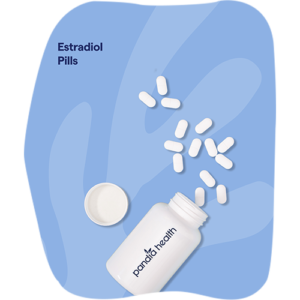Welcome to our dedicated page on Menopausal Hormone Therapy (MHT) for menopausal women. Navigating the journey of menopause can be challenging, with physical and emotional changes that might feel overwhelming at times. Hormone Replacement Therapy, a medical treatment often prescribed during menopause, aims to alleviate these symptoms and improve quality of life.
Whether you’re new to the concept of MHT or have been contemplating it for a while, this page serves as a guiding resource, providing answers to many of the questions you may have. Let’s walk through this journey together, supporting each other in the pursuit of health, well-being, and the most comfortable menopausal transition possible. Welcome aboard!
Menopausal Hormone Therapy is the most effective medical treatment to reduce menopause symptoms as well as perimenopause symptoms.
As mentioned before, when the transition to menopause starts, the ovaries begin to produce fewer female hormones (estrogen and progesterone). This shift can lead to several uncomfortable symptoms, ranging from hot flashes and night sweats to mood swings and sleep disturbances. mHT aims to balance these hormone levels, minimizing symptoms and enhancing your overall well-being during this significant life stage.
The hormones involved in menopausal hormone replacement therapy are primarily:
If you are experiencing symptoms of menopause, it’s important to speak with a doctor to determine if hormone replacement therapy is a safe and appropriate treatment option for you. Our expert doctors can assess your individual health status and family medical history to determine if this is the best option for you to alleviate your symptoms.
Sign up for an online consultation with our menopause certified doctors.
Get StartedMenopause Hormone Therapy (previously known as HRT) can provide a multitude of benefits that can significantly improve the quality of life for women experiencing menopausal or perimenopausal symptoms. These benefits span both physical and psychological aspects of women’s health, addressing the myriad of changes that menopause brings.
One of the primary benefits of HRT is the relief it provides from common menopausal symptoms. By steadying the levels of estrogen and progesterone in the body, HRT can help:
Studies have also highlighted HRT’s potential role in reducing certain health risks. Some women undergoing HRT may be less likely to develop heart disease. Research indicates that younger menopausal patients, specifically those who start HRT before age 60 or within ten years of menopause, may see a reduction in coronary artery disease. This finding challenges early concerns about increased cardiovascular risks associated with HRT that were found when older women were studied.
Beyond managing specific symptoms and health risks, HRT is recommended by many medical professionals as a means to generally improve the quality of life for menopausal women. In fact, experts argue that HRT is beneficial and safe for most women, especially if started early during the menopause or perimenopause years. It’s seen as a low-risk treatment option that can significantly improve patients’ daily life, following a detailed review of their symptoms and a comprehensive discussion about the risks and expectations from therapy.
The benefits of HRT extend well beyond symptom management, offering women the potential for a more comfortable and fulfilling life during their menopausal years. As with any treatment, consulting with a healthcare provider is essential to understand the full scope of benefits and potential risks.

Hormone replacement therapy (HRT) or menopausal hormone therapy (mHT) is an effective treatment for many symptoms of menopause, but it’s not without potential risks and side effects. These risks can depend on several factors including the type of hormone therapy, the dose, the duration of medication, and an individual’s specific health risks.
In clinical trials, HRT that included estrogen-progestin was found to increase the risk of certain serious conditions:
It’s crucial to note that these risks vary depending on several factors. For instance, women who begin hormone therapy at age 60 or older or more than 10 years from the onset of menopause are at greater risk of the above conditions. However, if hormone therapy is started before the age of 60 or within 10 years of menopause, the benefits appear to outweigh the risks. The type of hormone therapy also plays a role in risk variation. For example, the risks associated with hormone therapy differ depending on whether estrogen is given alone or with progestins, and on the dose and type of estrogen and/or progestin. An individual’s family history,personal medical history and risk of cancer, heart disease, stroke, blood clots, liver disease, and osteoporosis are also essential factors in determining whether HRT is a good fit. If you are experiencing menopausal symptoms and considering HRT, it’s important to discuss and weigh out the potential risks and benefits with a professional doctor to determine if it’s a safe and appropriate treatment option for you.
There are strategies to reduce the risks associated with HRT:
Find out if HRT is the best treatment for you and get a prescription online today!
Get Started
There are different types of HRT available, including estrogen-only therapy (ET) and combined estrogen-progestin therapy (EPT). The type of therapy used will depend on individual needs and medical history.
This is the most effective treatment for relieving menopausal hot flashes, and is mostly suitable but not limited to women who have had a hysterectomy. This is because estrogen alone can cause the growth of the lining of the uterus (endometrium), thus increasing the risk of endometrial cancer.
Estrogen therapy comes in several forms:
If you still have your uterus, taking estrogen without progesterone raises your risk for cancer of the endometrium, the lining of the uterus. To eliminate this risk further, your doctor may prescribe a progestogen along with estrogen. Progestogens can be synthetic (progestin) or natural (progesterone). There are synthetic versions in order to increase shelf-life and to allow the progestin to be combined with estrogen in convenient dosing regimes (ie. in the same patch or pill package). They come in several forms:
For women who still have their uterus, combined hormone therapy is usually recommended to decrease the chance of endometrial cancer. Forms of combined therapy include:
Tibolone is a synthetic hormone that acts like estrogen, progesterone, and testosterone in different tissues throughout the body. It’s not available in the United States, but it is used in many countries to treat symptoms of menopause and prevent osteoporosis.
SERMs mimic the effects of estrogen in some parts of the body, such as the bones, but act as an estrogen blocker in other areas. Raloxifene (Evista) is an example of a SERM that’s used to prevent osteoporosis and reduce the risk of invasive breast cancer in postmenopausal women. SERMS have different effects on different target tissues. Ospemifene is an approved, scientifically tested, safe and effective treatment for vulvovaginal dryness and dyspareunia (painful sex) while Raloxifene will create increased vaginal dryness and irritation. Each woman’s treatment plan should be personalized for her.
Some pharmacies can create (“compound”) hormones according to a doctor’s order. This can allow for personalized doses or a combination of hormones. However, compounded hormones haven’t been tested for safety or efficacy in the same rigorous manner as commercially available hormones, and they aren’t recommended by many medical organizations due to concerns about inconsistency in doses and purity.
It’s important to remember that the type of hormone therapy chosen will depend on a woman’s individual menopausal symptoms, medical history, and personal preference. Also, all forms of HRT have potential risks and side effects, which should be discussed with a healthcare provider. The goal is to find the most effective form of relief for menopause symptoms while minimizing potential risks.
This method consists of women taking estrogen every day, followed by estrogen plus progesterone for approximately 12-14 days of each calendar month. This type of cyclical HRT is mostly recommended for women that still have a fairly regular cycle. For example, women who have not yet had their last menstrual period or are still early in their transition.
Yes, both terms refer to the same treatment for menopause. Hormone Replacement Therapy (HRT) is an older term that was changed because the treatment is actually not replacing hormones in a woman’s body. During menopause, a woman’s body experiences a natural decline to have less estrogen and progesterone so, technically, those hormones don’t need to be replaced, but supplemented. The most updated term is menopausal hormone therapy (mHT) but hormone therapy (HT) is also used and accurate. Should you encounter the term, HRT, understand that it is referring to mHT.
Much like in menopause, perimenopausal symptoms also include weight gain, fatigue, insomnia, anxiety, depression, low libido, brain fog, problems with short-term memory, and genitourinary syndrome (including vulvovaginal and bladder due to changes in the genitourinary tissue caused by the drop in estrogen). To ease them some women can be candidates for hormone replacement therapy (or mHT as we have been presenting it). The main difference is how the treatment will be prescribed and taken by the patient. This treatment pattern is known as Cyclical Hormone Replacement Therapy.
Cyclical Hormone Replacement Therapy (HRT) is a method of hormone replacement that mimics the natural hormonal fluctuations in a woman’s menstrual cycle, providing a comprehensive approach to managing perimenopausal symptoms. By closely aligning with the body’s rhythm, this therapy involves the administration of estrogen and progesterone in a pattern that follows the monthly cycle, typically with a brief break in hormones.
If a woman has not had a hysterectomy (still has a uterus), progesterone is included in the treatment plan using capsules, a progesterone intrauterine device, or as a combination within an estrogen/progesterone patch. Progesterone should never be applied as a cream or gel because transdermal application is not as effective to protect the uterine lining from cancerous changes that can result if estrogen is used alone. This hormone is crucial in protecting the lining of the uterus (endometrium) from excessive thickening, which can lead to a condition called endometrial hyperplasia. This aspect of cyclical HRT is particularly important for women who still have their uterus, as estrogen alone can increase the risk of endometrial hyperplasia.

The varying levels of hormones delivered to the body in this specific manner allow for a monthly withdrawal bleed, resembling a natural menstrual period. As such, Cyclical Hormone Therapy is primarily recommended for women who are early in their transition, either perimenopausal or early postmenopausal.
Perimenopausal women experiencing severe symptoms can explore the option of cyclical HRT after consulting with a healthcare professional. A doctor will evaluate their individual family medical history and needs, ensuring a tailored approach to their hormonal balance and well-being. The key to this conversation is often to make the perimenopausal bleeding more regular and predictable, while also providing some symptom relief with mHT.
Additionally, women undergoing cyclic hormone therapy should maintain a balanced diet and regular exercise regimen to maximize the benefits of the treatment. Healthy lifestyle habits can further aid in managing perimenopausal symptoms, improving bone health, and maintaining cardiovascular wellness. It is also advisable to limit alcohol consumption and quit smoking as these habits can exacerbate menopausal symptoms and have additional health risks.
Remember, cyclical hormone therapy is one part of a comprehensive approach to managing perimenopause and improving quality of life. It is essential to consider all aspects of wellness, including mental health. Mindfulness practices, such as yoga and meditation, can help manage the emotional and psychological changes that often accompany the menopausal transition.

Each menopausal hormone therapy option is different, and therefore each cost is unique. For specific cost information, explore our menopause treatment products to find information respectable to your prescription.
Menopause Hormone Therapy (mHT) can help alleviate specific menopause symptoms. Are you wondering how? Here’s how mHT can help with three common symptoms of menopause:
It’s important to note that mHT is not the only treatment option for menopause symptoms, and it may not be appropriate for everyone. If you are experiencing menopause symptoms, it’s important to talk to your healthcare provider about the potential benefits and risks of mHT, as well as other treatment options that may be available to you.
Every woman’s menopause journey is unique, and what works best for one person may not work for another. However, if you’re experiencing uncomfortable symptoms of menopause, hormone therapy may provide the relief you need.
Here’s a few key reminders summarized from the guide as to why HRT might be right for you:
While hormone therapy can be effective in reducing menopause symptoms, it’s not recommended for everyone. Women with a history of certain medical conditions, such as breast cancer or blood clots, may not be eligible for HRT but there may still be relief available in other forms of treatment. This is why it is important to get expert medical advice from doctors who specialize in menopause, only at Pandia Health.
There is no specific set of signs that indicate a woman needs menopausal hormone therapy, as every woman’s menopause journey is unique. However, there are some common symptoms that may suggest HRT could be a viable treatment option. It’s important to discuss any signs or symptoms you’re experiencing with your personal medical history in order to determine the best course of treatment for you. They can assess your individual health status and provide guidance on whether HRT is a safe and appropriate treatment option, or if alternative treatments should be considered.
Whether or not Hormone Replacement Therapy is covered by insurance depends on your individual health plan and insurance provider. While most insurance plans do cover some forms of HRT, the amount of coverage can vary widely. It’s important to check with your insurance provider to determine if HRT is covered under your specific plan.
Hormone Replacement Therapy (HRT) can be safe for many women, but its safety depends on various factors such as the duration of treatment, individual health status and the type of hormones used. Short-term use of HRT is usually considered safe but long-term use has been associated with certain health risks. The decision to use progesterone and/or estrogen therapy should be made in consultation with a healthcare provider, who can assess individual risk factors and determine the best course of treatment.
The type of menopausal hormone therapy best for menopause depends on an individual’s health status, symptoms, and personal preferences. This is pertinent as there are different types of HRT available, including estrogen therapy, progesterone therapy, and combination therapy. It’s important to discuss the potential benefits and risks of each type with a healthcare provider to determine the best course of treatment.
The cost of hormone therapy for menopausal symptoms can vary widely depending on several factors, including the type of therapy used, the duration of treatment, and individual health plan coverage. In general, the cost of HRT can range from several hundred to several thousand dollars per year, depending on the specific treatment regimen.
It’s important to check with your insurance provider to determine if HRT is covered under your specific health plan, as insurance coverage can help reduce out-of-pocket costs. Some HRT medications may also be available in generic forms, which can help lower costs. Check out affordable prices for HRT medications, only from Pandia Health.
For additional information and resources, we recommend visiting the North American Menopause Society.
Hormone replacement therapy (HRT) can be an option for managing perimenopause symptoms. However, it is important to consult with a doctor who specializes in menopause and hormone therapy to determine if HRT is suitable for you based on your individual health history and needs. They will be able to provide personalized advice and guidance on whether starting HRT in perimenopause is appropriate for you.
Cyclical hormone replacement therapy (HRT) is a specific approach to hormone replacement therapy that aims to replicate the natural hormonal fluctuations of the menstrual cycle. It involves taking estrogen and progesterone in a cyclical pattern. This approach is particularly beneficial for women who still have their uterus and may be early in their peri/menopausal transition, as it helps prevent endometrial hyperplasia, a condition where the lining of the uterus becomes thickened. By following a cyclical pattern of hormone therapy, women can experience the benefits of hormone replacement while also reducing the risk of endometrial hyperplasia and, in many cases, make bleeding more predictable until they are fully postmenopausal. This approach can help alleviate menopausal symptoms and improve the overall quality of life for women going through the menopausal transition.